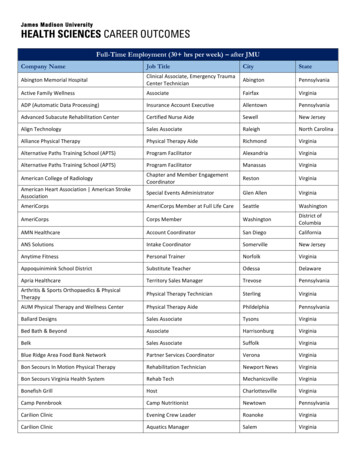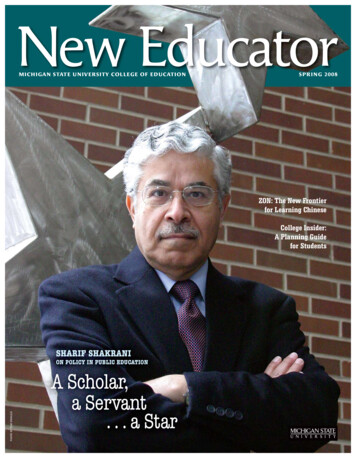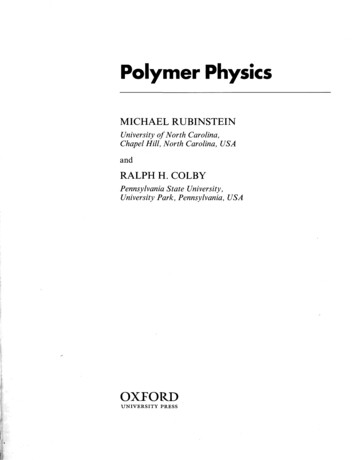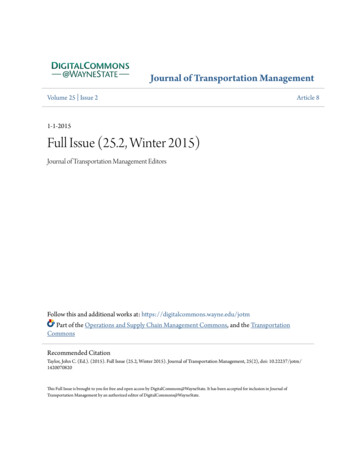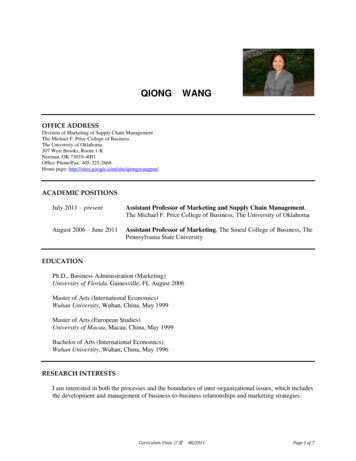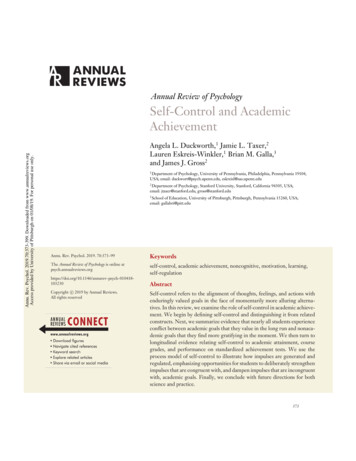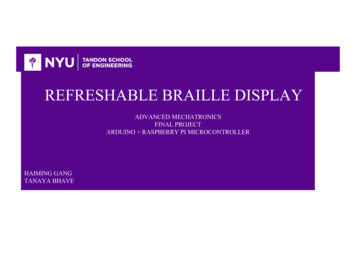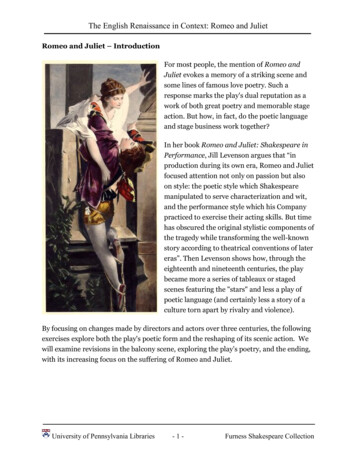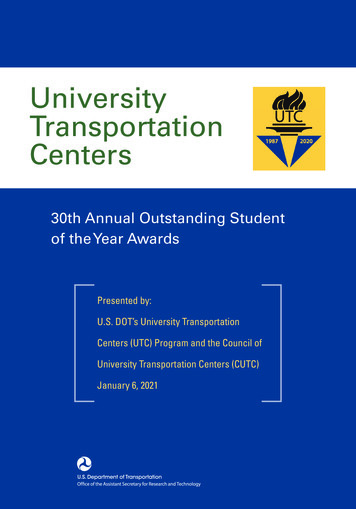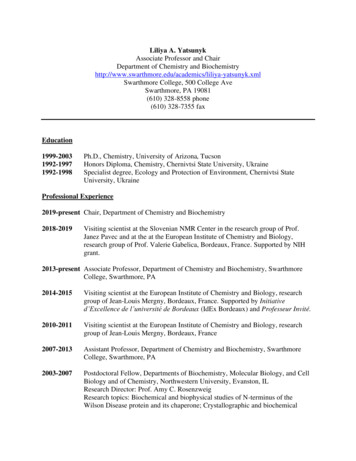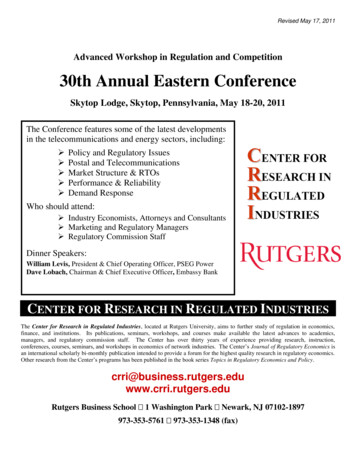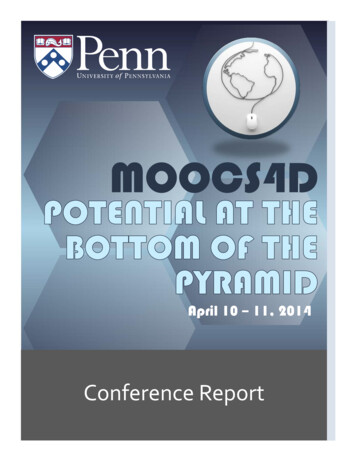
Transcription
MOOCS4DApril 10 – 11, 2014Conference Report
AcknowledgementsThis report is based on a conference–MOOCs4D–that was organized by the Graduate School of Education atthe University of Pennsylvania, and was co-sponsored by the Office of the Provost of the University ofPennsylvania, Annenberg School for Communication, School of Engineering and Applied Science,Perelman School of Medicine, School of Nursing, The Wharton School and Penn Libraries. Additionalsupport provided by Microsoft, Coursera, United Nations Educational Scientific Cultural Organization(UNESCO), International Council for Open and Distance Education, Organisation International de laFrancophonie, and Commonwealth of Learning.The conference was co-chaired by Dan Wagner (Professor and Director, International EducationalDevelopment Program, Graduate School of Education and Joseph Sun (Vice Dean, School of Engineeringand Applied Science). Staff support was provided by: Allison Born, Vasey Coman, Nathan Castillo, LauraConrad, Desmond Diggs, Jiayue Fan, Olatokunbo Fashoyin, Ruchira Goswami, Fabiola Lara, Maha Laziri,Jinsol Lee, William Lodge II, Katie Maeve Murphy, Jessica Peng, Sarah Qiao, Adam Saks, Amy Saul, MiaSasaki, Cassandra Scarpino, Lauren Scicluna-Simon, Ronggui Su, Norma Ureña, Chia-Wei Wu, MohamedOsama Youssef, and Fatima Tuz Zahra.The conference faculty planning committee consisted of: Martha Brogan (Penn Libraries), Harvey Friedman(School of Medicine), Robert Ghrist (School of Arts and Sciences), Sarah Kagan (PennNursing), Katherine Klein (Wharton School of Business), Carrie Kovarik (School of Medicine), SherrylKuhlman (Wharton School of Business), Bobbi Kurshan (Graduate School of Education), Rahul Mangharam(School of Engineering and Applied Sciences), Laura Perna (Graduate School of Education), and MonroePrice (Annenberg School of Communications).We would like to especially thank the dozens of invited speakers who came to Philadelphia from more than25 countries, as well as the nearly 150 people who participated in the intensive two days of discussions.This report was prepared by a team consisting of: Jessica Peng, Jinsol Lee, Desmond Diggs and DanWagner. We thank Allison Born, Nathan Castillo, Laura Conrad, Ruchira Goswami, Maha Laziri, KatieMaeve Murphy, Adam Saks, and Fatima Tuz Zahra for their written contributions. We also thank FabiolaLara for several of her photos that appear in this report. Further updates, as well a videos and powerpointpresentations, may be found on the website: www.moocs4d.org. July 2014 The Trustees of the University of Pennsylvania. All rights reserved.MOOCs4D: Potential at the Bottom of the Pyramid2
TableofContentsIntroduction4Plenary Session 1: The Advent of MOOCs5Panel A: Economics of MOOCs6Panel B: National and Global Perspectives7Panel C: MOOCs, ODL, and OER8Plenary Session 2: MOOCs and International Development9Plenary Session 3: The MOOCs Challenge10Panel D: Expanding Inclusion11Panel E: Building Global Capacity in Digital Information Resources: Creation,Sharing and Use12Panel F: Overcoming Digital Infrastructural Constraints13Panel G: MOOCs and Higher Education Institutions14Panel H: Global Health15Panel I: Authorship and Ownership16Panel J: K-12 Teacher Professional Development17Panel K: Blended Learning and Innovative Instruction18MOOCs4D: Potential at the Bottom of the Pyramid3
IntroductionThe recent rise of Massive Open Online Courses (MOOCs) has generated significant media attention fortheir potential to disrupt the traditional modes of education through ease of access and free (or low-cost)content delivery. To date, nearly all of the attention has been on how major research universities can createtheir content for worldwide consumption. The vision of the MOOCs4D Conference was to focus theconversation specifically on the developing world by broadening the discussion to consider: new definitionsof MOOCs, new frameworks for the utilizations of MOOCs, and new directions for MOOCs in the lowincome countries.The popularity of MOOCs may be seen through an increasing demand for post-secondary enrollment that ispredicted to increase from 150 million students in 2009 to 250 million students in 2025. MOOCs have adistinct advantage in that they use technology to scale, and are able to provide learning opportunities tomany more individuals than traditional brick-and-mortar institutions. Not only do MOOCs hold out theprospect of greatly expanding capacity to meet growing demand worldwide, but they also offer the potentialof enabling access to high quality education to all persons regardless of socioeconomic status, even in themost impoverished and under-served regions of the world.These developments have generated considerable excitement in higher education worldwide. CurrentMOOC platforms have students registered in nearly 200 countries, with about two-thirds from US andWestern Europe regions, about 6% from Brazil, 5% from India, 4% from China, and the remainder fromeverywhere else. And these numbers may be changing rapidly. With such a rapid worldwide expansion,there are concerns about the relevance of content offered, languages of instruction, how to meet diverselearning needs, cultural differences in teaching, and accessibility in various regions with poortelecommunications infrastructure.Consequently, the MOOCs4D International Invitational Conference brought together scholars, policymakers, program officers, administrators, and technologists from the education and internationaldevelopment sectors. Through discussions from a wide array of perspectives, the conference aimed to betterunderstand the dynamics surrounding this situation, and deliberate on solutions and action plans that willenable MOOCs to serve the development needs of resource-poor communities of learners – those at the"bottom of the pyramid."This Report, therefore, is designed to be the beginning of a conversation (and debate) on the future ofMOOCs from a global perspective. The research to date–as summarized in the panels that follow–is thin.Many claims about MOOCs abound, but the field is so new that much is conjecture. There can be littledoubt, however, that we will know a great deal more in the coming years, and that the field of globaleducation will impacted in very important ways.MOOCs4D: Potential at the Bottom of the Pyramid4
12PlenarySession1:TheAdventofMOOCsModerated by Joseph Sun, Vice Dean for Academic Affairs at theSchool of Engineering and Applied Science (SEAS), Plenary 1 TheAdvent of MOOCs included presenters: Abdul Waheed Khan, formerAssistant Director General for Information and Communication atUNESCO, Paris and past Vice Chancellor (President and CEO) of theIndira Gandhi National Open University, Bakary Diallo, Rector of theAfrican Virtual University (AVU) and Michele Petochi, ManagingDirector at the École Polytechnique Fédérale de Lausanne (EPFL) inSwitzerland.“Howdoweservepeopleinresource- ‐poorenvironments?”- ‐MichelePetochiAbdul Waheed Khan began the plenary by referencing what he termedthe earliest forms of MOOCs nearly thirty-five years ago in the ruralareas of India where a food shortage was crippling the population.Through a public-private partnership with the public service radio and acombination print, and in-person support, Khan explained that theintervention was effective because it: 1) tackled a local problem, 2)employed the local language, 3) included a range of stakeholders, 4)included incentives for participants and 5) had hands on support. Headded that the single greatest catalyst for the proliferation of MOOCs isthe massive unmet need of educational opportunities for learners inemerging contexts.Additionally, Khan reflected on his time at the Open University wherehe cited the cornerstone of their success as their ability to design courses that matched the skillsets of the marketplace. The 3,500 learning centers erected by Open University were a result of strategic partnerships with public andprivate institutions that sought out the skills of learners and were equally invested in pupils’ success. Tailor-madeprograms for the engaged industries resulted in curriculum that specifically equipped learners with requisite skills todeliver in the workplace. In closing, Khan suggested that the MOOCs of today are similar to the ones he firstencountered thirty-five years ago, and can be successful following the same formula of relevant and relatable contentthat address local issues, utilize local languages, and are responsive to the dynamics of emerging learners.Bakary Diallo’s presentation, entitled “Pragmatism before Popularity,” shared both the challenges faced by the 19partner universities of the African Virtual University (AVU) and a roadmap for future initiatives capitalizing on thegrowing capacity of MOOCs to meet the needs of learners on the continent. Of the numerous challenges he shared,those specific to Sub-Saharan Africa included the gap in national and institutional policies to accredit learners,resistance to a change from the standard “brick and mortar” institutions, and the scarcity of human resources tosupport new initiatives. Despite the challenges, Diallo purported AVU is positioning itself to take full advantage ofrecent developments. Fiber optics penetration, alternative power sources, cheaper and more varied mobiletechnologies, and a projected 513 million in revenues from eLearning suggest that MOOCs and other open onlinelearning platforms are a viable avenue for emerging learners. Diallo particularly highlighted Massive Open OnlinePrograms (or MOOPs) which he defined as low bandwidth platforms, with accreditation in all AVU countries inorder to increase both access and completion rates.Michele Petochi of the EPFL placed MOOCS in the general context of emerging technologies and suggested thatMOOCs are experiencing a normal hype cycle, but nonetheless concluded that they are certainly here to stay. Acentral theme of the his presentation was case made for learner-centered trajectory for future MOOCs while raisingthe question; “How do we serve people in resource-poor environments?” Petochi suggested that despite design formassive numbers, programs for the needs of specific groups should certainly be the aim. Moreover, he suggested thatpedagogy to be dictated not by tradition but by the individualized needs of learners.MOOCs4D: Potential at the Bottom of the Pyramid5
12WhyMOOCsfortheBottomofthePyramid?One of the main critiques of MOOCs is their lack ofcontextualization in terms of technology access, language,and content, at the bottom of the pyramid (BOP).MOOCs4D bring a new approach by investing in thecreation of MOOCs that can be linguistically diverse,technologically accessible, and use content that is simpleand reachable to audiences with basic levels of education.To reach the BOP is a major challenge.PanelA:EconomicsofMOOCsWhen looking at the prospect of MOOCs reachingthe bottom of the pyramid, it is necessary to discussthe economics of such a possibility. The presenters inthe panel, Economics of MOOCs, explored variousbusiness models and questioned the potential ofMOOCs working in developing countries based onthese models.Clara Ng from Coursera discussed the idea of valuecreation as a necessary component for MOOCs tosucceed in developing contexts. Consideringresource-constrained environments, it is key to beaware of the costs to both the learners anduniversities. Ng determined that the costs includedboth time and money. Specifically, learners faceopportunity costs, which may prevent them fromseeing the value in taking a MOOC. The necessaryvalue creation would need to overcome theopportunity costs to learners and the production coststo universities. Ng insisted, “When these costsbecome prohibitive, that’s when the entire marketbreaks down.” Attempts at off-setting costs haveincluded compensation for faculty and “freemium”models for students. The “freemium” model is suchthat the class itself is free but premium services suchas proof of completion are an additional fee. Ngconcluded with the statement: “By understanding thecosts and the value that is generated for bothuniversities and learners, we can create an ecosystemthat is sustainable.”From the OECD Directorate of Education and Skills,MOOCs4D: Potential at the Bottom of the PyramidMichele Rimini built off of Clara Ng’s presentation byquestioning the true definition of a MOOC. In hiscomparison between Open Educational Resources(OER) and MOOCs, he asked: “Are MOOCs aninclusive innovation in education?” In looking to answerthis question and improve accessibility, he presentedfive business models: 1) public-private entities used forfunding; 2) institutional enlargement; 3) freemiummodel, as mentioned earlier; 4) advertising by collectingpersonal data and targeting ads to users; and finally 5)professional training used by organizations. Yet, themain question posed with every model was: can it workin developing countries?Finally, representing the International FinanceCorporation (IFC), Juliana Guaqueta discussed herorganization’s recent focus on how MOOCs can be anew way to address both gaps in access and quality.Agreeing with the aforementioned business models andcost-benefit discussion, Guaqueta maintained that anymodel must be able to be scaled up at affordable pricesand that there must be a balance in supply and demandfor it to be successful.In summary, the three speakers asserted that whenlooking at the economics of MOOCs, the businessmodel must be sustainable. While they did not concludethat any one model was the best, they agreed thatwhichever model used must also be linked to what boththe learners and producers need in order to moveforward. The best model will match with the educationneeded to produce learners with valuable skills for theworkplace as well as provide incentives for the creatoror sponsor.6
12PanelB:NationalandGlobalPerspectivesWith the expansion of technologies across the world,the opportunities and challenges of MOOCs areimportant to consider from both national and globalperspectives. Concerns regarding MOOCs varywidely across countries, ranging from accessibility ofinfrastructure, resource capacity, language ofinstruction, relevance of content, and culturalperceptions of online learning. By examining theneeds in different settings, a deeper and broaderunderstanding of the future impact of open onlinecourses can be gained for the developing world. As aresult, representatives from universities acrossmultiple continents shared their perspectives onMOOCs and its potential in their specific contexts.At the Mongolian University of Science andTechnology (MUST), Turbat Renchin described theinitiatives of developing an open educationalplatform. The main objectives of the programinvolved: 1) setting up a framework for e-learningpolicy coordination; 2) developing an open e-contentand methodology; 3) forming mechanisms of openand e-learning services and activities; 4) developinghuman resource capabilities; and 5) setting upenabling environment for carrying out e-learningprograms. Through the implementation of theprogram in a Learning Management System, theuniversity sought to “provide education beyonddependence of location and time frame byintroducing flexible, open, accessible, variable,quality, and effective framework of learningapproach.”Additionally, as the vice president of the VietnamNational University of Ho Chi Minh City, NguyenHoi Nghia discussed ways that MOOCs can benefitstudents in Vietnam, particularly by addressing thegrowing demand for higher education that currentlyremains unmet by the formal education system. Someof the potential advantages of MOOCs in Vietnaminclude reduced costs, productivity and efficiency,standardization, and increased accessibility. Thecurrent opportunities for MOOCs developmentidentified in Vietnam are seen as a supplement fortraditional classes and for practical skills instruction,with a long-term plan for possibly initiating onlinecourse programs that lead to certification. However,some of the obstacles for development includecultural perceptions that distance education produceslow quality education in society, limited InternetMOOCs4D: Potential at the Bottom of the Pyramidinfrastructure in remote areas, low independent learningskills of Vietnamese students, and insufficient numbersof teaching staff. With these concerns in mind, theuniversity intends to establish a center for MOOCsdevelopment that collaborates with partners worldwideto deploy courses online, particularly focusing onpractical skills instruction for students.Meanwhile, Nodumo Dhlamini emphasized theinformation, communication, and knowledgemanagement components of MOOCs, as a representativefrom the Regional Universities Forum for CapacityBuilding in Agriculture (RUFORUM). The Forum,which addresses higher agricultural education issues invarious parts of Africa, implemented an ICT program inorder to tap global innovations in university educationand to improve access to RUFORUM’s core programsthrough eLearning. The program achieved a number ofmilestones including groundwork for effective ICTimplementation at universities, development of elearning policies and strategies for technology-mediatedlearning, and better dissemination of agriculturalresearch. Even though challenges regardingsustainability and demand for ICT support posedpotential barriers, Dhlamini proposed an ICTcommunity of practice to address these issues andpromote successful development of MOOCs.As demonstrated in these examples, countries around theworld are making significant strides in understandingand utilizing online learning in developing contexts.Through the expansion of MOOCs, national and globalperspectives remain critical in improving the future ofeducational development.7
12PanelC:MOOCs,ODLandOERThe MOOCs, ODL and OER panel focused on howMOOCs and Online Distance Learning (ODL) requireOpen Education Resource (OER) for success. Issuesincluded ownership and intellectual property, fair use,English-language dominance, and creation of locallyappropriate MOOCs. The need for awareness of OERfor the success of MOOCs was also addressed.Rory McGreal, UNESCO/Commonwealth of LearningChairholder in Open Educational Resources atAthabasca University and Canada’s Open University,argued that copyright and intellectual property areprivileged monopolies allowing publishers to controlcontent. Extending this idea to MOOCs, McGreal said,“You learn, but you don’t own what you learn, Courseraowns it.” OER is essential and unless we create clarityfor fair use, localization of and access to MOOCs isimpossible.Dendev Badarch, UNESCO Representative to theRussian Federation and Acting Director of the UNESCOInstitute for Information Technologies in Education(IITE), focused on ICT use for primary educationteacher training through MOOCs and ODL. Badarchsaid, “ICT used well by good teachers can enable everychild to achieve their learning potential.” IITE is alsogathering non-English OER case studies to addresslanguage barriers, OER awareness, and OER andteaching verychildtoachievetheirlearningpotential.”- ‐DendevBadarchFinally, Ticora Jones, Senior Advisor and ProgramDirector in the USAID Office of Science andTechnology managing the Higher Education SolutionsNetwork, spoke about the need to rate and aggregateOER. She argued for the need to ensure qualityresources that are locally appropriate. Calling for OERto focus on big ideas, Jones stated, “We shouldchallenge ourselves to think of how we create lifelongdesigners and builders and problem solvers.”The panelists agreed that access and language issuesmust be overcome for MOOCs and OERs to succeed.However, the concern that OER will battle withpublishers for acceptance still remained unresolved atthe end of the panel. The panel also raised issuesregarding whether English really should be theinternational language of MOOCs and OER.CanMOOCsprovidecontextualizedcontent?Early attempts at merely translatingexisting content or having local professorsgive lessons on foreign concepts isinsufficient. In MOOCs4D, moreemphasis needs to be placed on providinga truly culturally appropriate environment,developed in collaboration with localexperts, so learners can better engage withthe content.MOOCs4D: Potential at the Bottom of the Pyramid8
Moderated by Mohamed Maamouri, Senior Researcher andResearch Administrator at Penn’s Linguistic Data Center, thesecond plenary, MOOCs and International Development, featuredPapa Youga Dieng, Coordinator of the Initiative francophone pourla Formation à Distance des maîtres at the OrganisationInternationale de la Francophonie (OIF), Sandra Klopper, DeputyVice-Chancellor at the University of Cape Town, South Africa, andSteven Duggan, Director of Worldwide Education Strategy at theMicrosoft Corporation.Papa Youga Dieng presented an institutional perspective from the OIF. As the institution's strategic plan 2002-2015calls for direct support of the education sector, the OIF is presently invested in three flagship initiatives; in-servicetraining programs for teachers in primary schools and head of primary schools throughout Francophone Africaknown as ifadem (ifadem.org); Examen.sn, a Senegalese-based intervention which targets pupils in primary andsecondary schools as well as their teachers and parents; and REL 2014 a MOOC on open educational resources(OERs). Dieng described a number of barriers to success of MOOCs and OERs, including the a shortage of qualifiedteachers (between 40-60%), and limited infrastructure to support access to poor communities. The opportunities thatthe OIF recognizes as areas for growth for OERs address the outlined challenges in areas such as teacherprofessional development, multiple modal delivery of educational resources, and the use of mobile technology andalternative energy sources.Sandra Klopper of the University of Cape Town referenced her experience throughout Africa in higher education butwas careful to qualify her perspective as strictly in reference to Anglophone Africa. Klopper described the MOOCsphenomena, from the African perspective, as being nearly exclusively consumers of MOOCs. Klopper made a casefor MOOCs to showcase African knowledge and expertise, and as an opportunity to use the platform in order toprovide interventions for bridging the gap of skills between secondary and tertiary education. In her overview of thechallenges of MOOCs, she referenced the major costs associated with expertise required to produce content. Klopperhighlighted two models of success using wrapped/blended education initiatives in Africa: Makarere University'sprogram to improve the productions and economic performance of dairy farms using OER and a World Bank andTanzanian Commission for Science and Technology partnership that recently launched a pilot to meet the needs ofstudents who need market-relevant IT skills.In his presentation entitled, “Anytime, Anywhere, Learning for All: Technology, education and equality of resourcescan be focused to deliver personalized learning experiences,” Steven Duggan contended that the current modalitiesare "failing everyone" from the students, to parents, to employers. Furthermore, he referenced his own experience inhis role at Microsoft extensively visiting classrooms around the globe and suggested most students, when asked, arecommonly unengaged and uninterested. Duggan also introduced a recent development at Microsoft known aslit4life.net. In an effort to address the 1 in 4 people on the world who are illiterate, Microsoft has designed thisportal, which allows anyone, anywhere, to create a book for free. It directly addresses the 31% percent of illiteratelearners who also live in illiterate homes. The books include text and illustrations as well as audio. Additionally,over 7,000 languages can be represented (some of which are classified as dying languages). The platform alsoincludes mechanisms to track new readers’ growing skills and point them to additional resources. Duggan concludedby sharing his vision of the classroom of the future as a technology-enabled environment that allows personalizedlearning seen formally only in apprenticeship arrangements. That technology, he stated, must be available to both thedeveloped and undeveloped world.MOOCs4D: Potential at the Bottom of the Pyramid9
PlenarySession3:TheMOOCsChallengeModerated by Dan Wagner, Professor of Education at the University of Pennsylvania, Plenary 3, The MOOCsChallenge, included presenters: Stephen Downes of the National Research Council (NRC) of Canada based inMoncton, New Brunswick, N.V. Varghese, the current director of the Centre for Policy Research in HigherEducation (CPRHE), New Delhi, and Russell Beale, Professor of Human-Computer Interaction at the University ofBirmingham. Wagner framed the conversation by posing the following questions: Have we reached a consensusregarding what we are talking about when we reference MOOCs, and what are the challenges in and for MOOCs indeveloping countries?Presenter Stephen Downes began by challenging the common rhetoric of the ability of MOOCs to democratizeeducation by suggesting that the democracy we have created is characterized by wealth concentration at the top andinherent inequalities for those at the bottom. Downes argued that the pyramid structure is a myth that is based on ascarcity of knowledge and resources. He contended, “There is enough knowledge for everyone and there is enoughaccess for everyone, but we have not taken it to heart to make that access and distribute that content to those whoneed it.” Referencing the first MOOCs launched in Canada in 2008, he stated that their success was due to the focuson a network of learning rather than the “super-professor model” he said we witness today. A theme throughoutDownes’ presentation was that basic design principles that should characterize MOOCs include: the autonomy of thelearners to pick their path, and the recognition of the diversity of learners (language, culture, and motives).N. V. Varghese began his presentation by giving a general overview of the rapidly expanding higher education needsof those in the developing world. Although he acknowledged the potential of MOOCs, he was quick to note that theMOOCs as we know them are commonly “romanticized” and are not the “blatant mechanism to expand highereducation.” Varghese defined the current global learning crisis stating that “the disparity in access is gettingnarrowed down but the disparity between achievement is widening.” He concluded by making the recommendationthat rather than viewing MOOCs as a standalone, independent, parallel activity, rather a partnership with existinginstitutions of higher education could lead to expansion in enrollments and local access to education in developingcountries.Russell Beale shared perspectives from Future Learn, the UK MOOC offering which was founded by the OpenUniversity and consists of over 30 partners. Much as with the internet, Beale contended that MOOCs must migratefrom a model of content being put up for learners to a space where learners can gain a socially interactive experiencethat is centered around the way the learner chooses to engage and takes into account the platform that pupils use forcontent delivery. To that effect, Future Learn is shaping their MOOCs to promote small group conversations andpeer learning/evaluations, apps and content that provide what he termed a “delightful user experience” on mobileplatforms, and with built in analytics that measure how learners use the software.The presenters concluded the plenary by briefly sharing their thoughts on the up and downsides of MOOCs. The propoints included the infrastructure for people to create and engage in their own learning environments throughenabling technology, while the downsides focused on the capacity of MOOCs to eliminate the diversity of educationby focusing on elite institutions which may further reinforce the pyramid frame of educational whoneedit.”–StephenDownesMOOCs4D: Potential at the Bottom of the Pyramid10
12PanelD:ExpandingInclusionExpanding inclusion is one of the central foci forexpanding effective use of MOOCs in the developingworld. The speakers at the panel on Expanding Inclusionspoke about various forms of inclusion in MOOCs4D,advocating for an ideal where every human being hasaccess to knowledge and information.Masennya Dikolta, CEO of Molteno Institute ofLanguage and Literacy in South Africa, a non-profitorganization in the Limpopo province in South Africa,discussed the ways in which Bridges to the FutureInitiative expands inclusion along linguistic lines byenabling children and adults to learn reading in theirmother tongue with the use of technology. For Dikolta,inclusion in education is only possible once it islegislated through the mainstream education system torecognize a diverse set of learner needs.Minghua Li, professor at East China Normal UniversityCollege of Public Administration, discussed a ten-yearstudy focused on providing access to education toChinese migrant workers by establishing learningcenters near their work and living places. Li found thatalthough MOOCs can be created in any part of theworld, it is important to recruit “local mentors,facilitators who know about the problems and the needsof the people to teach with MOOCs.” He mentionedanother initiative named MOOCsinside, where localteachers use materials and content produced in the Westbut adapt it to the local context to meet the needs of theirlearners. Li further noted that there are two parallelmarkets for MOOCs: “one is the degree market, and theother one is the cause market.” In his opinion, there is amissing link between the two markets, as the needs ofthe
MOOCs4D: Potential at the Bottom of the Pyramid 6 Panel.A:.Economics.of.MOOCs. 1 When looking at the prospect of MOOCs reaching the bottom of the pyramid, it is necessary to discuss the economics of such a possibility. The presenters in the panel, Economics of MOOCs, explored various business models and questioned the potential of
